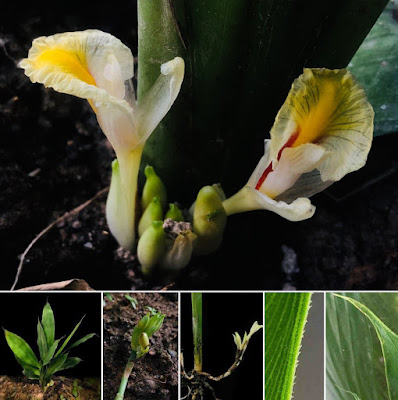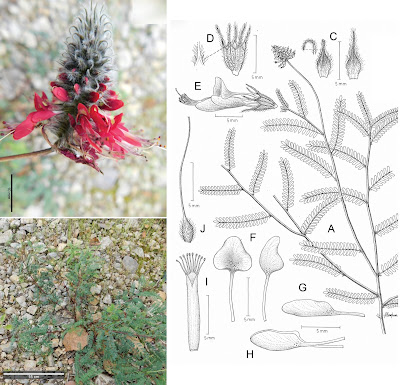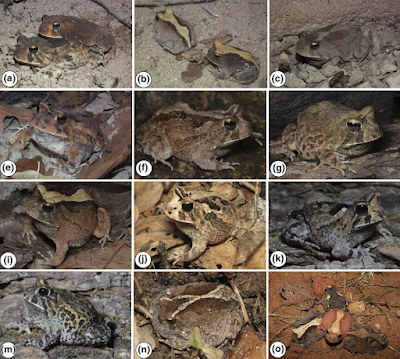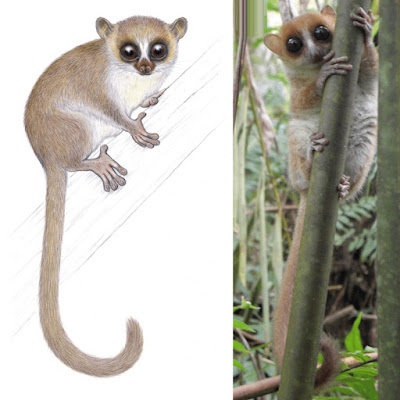[Most Recent Entries] [Calendar View]
Wednesday, July 29th, 2020
| Time | Event | ||||
| 1:03a | [Botany • 2020] Amomum foetidum (Zingiberaceae) • A New Species from Northeast Thailand
Abstract Amomum foetidum (Zingiberaceae), a new species from Northeast Thailand is here described, illustrated and photographed. The key to three species of Amomum which cited and treated in this paper is provided. Keyword: Amomum cinnamomeum, Amomum foetidum; New species; Northeast; Thailand; Zingiberaceae Amomum foetidum Boonma & Saensouk, sp. nov. Distribution: So far known from Sakon Nakhon province and mostly cultivated in Northeastern Thailand. Etymology: The specific epithet “foetidum” is derived from the Latin word refers to pungent odor which this plant emits the smell similar to the smell of the Stink Bugs (Tessaratoma papillosa Drury) when sniffing near its flower or crushed the part of this plant. Uses: used to substitute the stink bugs (Tessaratoma papillosa Drury) in cooking. Notes: all parts of the plant have a pungent odor similar to the smell of stink bugs (Tessaratoma papillosa Drury), bracts and peduncles are white when young or if it in the underground but it will be green if it above the ground. Thawatphong Boonma, Surapon Saensouk and Piyaporn Saensouk. 2020. Amomum foetidum (Zingiberaceae), A New Species from Northeast Thailand. Taiwania. 65(3); 364-370. | ||||
| 8:40a | [Botany • 2020] Dalea rubriflora • A New Outstanding Species and A New Section of Dalea (Fabaceae: Papilionoideae) from central Mexico
Abstract We describe and illustrate Dalea rubriflora A.E. Estrada, J. Martínez-Ramírez, A. Mares & Ocampo as a new species from central Mexico. According to the morphology of its flower, this new species is included in a new section within subgenus Parosela because the shape of its keel, the innermost petals (which make the flower valvate) coherent along their external (dorsal) outer margins. However, this new species and new section have striking differences with the rest of the previously described taxa of subgenus Parosela, highlighting 1) the persistent red color of the flowers, not found in any section and species of Dalea, 2) the stamens are joined in a very long staminal column which are protruded from the keel petals for almost a third of its length, and 3) the blades of the epistemonous petals are not auriculated, instead, are truncated in the keel and absent in the wings. These main features, associated with more particular characteristics of other sections, allow us to recognize Rubriflorae as a new section and Dalea rubriflora as a new species into the subgenus Parosela. Keywords: Eudicots, Central Mexico, Leguminosae, sect. Rubriflorae, Sierra del Laurel, Zacatecas
Dalea sect. Rubriflorae A.E. Estrada, sect. nov. Type:— Dalea rubriflora A.E. Estrada, J. Martínez-Ramírez, A. Mares & Ocampo. Etymology:— The name Rubriflorae of this monotypic section is derived from the red color (permanent ruby red color, even when dried) of its flowers. We added a key to recognize and to differentiate sect. Rubriflorae from the sections recognized by Barneby (1964). Dalea rubriflora A.E. Estrada, J. Martínez-Ramírez, A. Mares & Ocampo, sp. nov. Morphologically similar to Dalea viridiflora S. Watson (1886: 448) in growth form and single terminal spiked inflorescences; however, D. rubriflora has higher number of leaflets (11–16 vs. 7–11 pairs), much longer peduncles (11.5 cm long vs. 0.5–4 cm long), caducous bracts (persistent in D. viridiflora), and longer flower structures (calyx, banner, wings, keel, staminal tube, filaments, and anthers). Distribution and habitat:— As far as known, there is only one collection of Dalea rubriflora. The species was found in an oak forest with elevation of 2590 m in an area locally known as “Sierra del Laurel” (Fig. 3). More collection efforts are needed to know the actual distribution of the species, although it is likely to occur in the neighboring areas of the states of Aguascalientes and Jalisco. Etymology:— The epithet of the species refers to the characteristic and permanent red color of its flowers (Fig. 2). To our knowledge, this is the only species in the genus Dalea whose petals are completely red and keep this color even when the petals are dry. The banner has a yellow spot on its central part, but when the material is dried changes to white, although the rest of the banner remains red on both, inner and outer surfaces. Eduardo Estrada Castillón, Julio Martínez Ramírez, Andrés Alejandro Mares-Guerrero and Gilberto Ocampo. 2020. A New Outstanding Species and A New Section of Dalea (Fabaceae: Papilionoideae) from central Mexico. Phytotaxa. 454(2); 145–152. DOI: 10.11646/phytotaxa.454.2.6 | ||||
| 10:02a | [Herpetology • 2020] Revising the Taxonomy of Proceratophrys Miranda‐Ribeiro, 1920 (Anura: Odontophrynidae) from the Brazilian Semiarid Caatinga: Morphology, Calls and Molecules support A Single Widespread Species
Abstract Recently, Proceratophrys cristiceps was redescribed along with the description of two species from the Caatinga biome: P. aridus and P. caramaschii. However, only a small fraction of the populations related to such species in Northeastern Brazil was examined, and most populations of central Caatinga were not contemplated in this analysis. Comparisons were also based exclusively on external morphology, precluding a more accurate delimitation of such taxa in the light of multiple characters. Such geographic paucity and reliance in only one data source caused the species status of most central Caatinga populations to be uncertain. Thus, the revision of Proceratophrys populations from the Caatinga biome is of utmost importance to establish a solid taxonomic background and to test the validity of the described species. Based on morphologic, morphometric, acoustic, and multilocus genetic data, we define the range of inter‐ and intrapopulation variation in the parameters we analyzed, establishing which ones are useful as diagnostic characters for Proceratophrys in the Caatinga. We found no evidence supporting P. aridus and P. caramaschii as distinct species and thus place them as junior synonyms of P. cristiceps. Our results reinforce the importance of using multiple lines of evidence to avoid taxonomic instability. Keywords: acoustic, molecular, morphology, Proceratophrys aridus, Proceratophrys caramaschii, Proceratophrys cristiceps, synonymization Proceratophrys cristiceps (Müller, 1884 “1883”) Ceratophrys cristiceps Müller, 1883 Stombus cristiceps Miranda‐Ribeiro, 1920 Proceratophrys cristiceps Lynch, 1971 Proceratophrys aridus Cruz et al., 2012, S. Am. J. Herpetol., 7:118. Proceratophrys caramaschii Cruz et al., 2012 Sarah Mângia, Eliana Faria Oliveira, Diego José Santana, Ricardo Koroiva, Fernando Paiva and Adrian Antonio Garda. 2020. Revising the Taxonomy of Proceratophrys Miranda‐Ribeiro, 1920 (Anura: Odontophrynidae) from the Brazilian Semiarid Caatinga: Morphology, Calls and Molecules support A Single Widespread Species. Journal of Zoological Systematics and Evolutionary Research. DOI: 10.1111/jzs.12365 | ||||
| 11:27a | [Mammalogy • 2020] Microcebus jonahi • Ecology and Morphology of Mouse Lemurs (Microcebus spp.) in A Hotspot of Microendemism in northeastern Madagascar, with the Description of A New Species Highlights: - Two pairs of Microcebus species occur in partial sympatry. - Morphological distinctiveness supports genomic species delimitation in cryptic lemurs. - High plasticity in reproductive schedules in a lineage of habitat generalists detected. Abstract Delimitation of cryptic species is increasingly based on genetic analyses but the integration of distributional, morphological, behavioral, and ecological data offers unique complementary insights into species diversification. We surveyed communities of nocturnal mouse lemurs (Microcebus spp.) in five different sites of northeastern Madagascar, measuring a variety of morphological parameters and assessing reproductive states for 123 individuals belonging to five different lineages. We documented two different non‐sister lineages occurring in sympatry in two areas. In both cases, sympatric species pairs consisted of a locally restricted (M. macarthurii or M . sp. #3) and a more widespread lineage (M. mittermeieri or M. lehilahytsara). Estimated Extents of Occurrence (EOO) of these lineages differed remarkably with 560 and 1,500 km2 versus 9,250 and 50,700 km2, respectively. Morphometric analyses distinguished unambiguously between sympatric species and detected more subtle but significant differences among sister lineages. Tail length and body size were most informative in this regard. Reproductive schedules were highly variable among lineages, most likely impacted by phylogenetic relatedness and environmental variables. While sympatric species pairs differed in their reproductive timing (M. sp. #3/M. lehilahytsara and M. macarthurii/M. mittermeieri), warmer lowland rainforests were associated with a less seasonal reproductive schedule for M. mittermeieri and M. lehilahytsara compared with populations occurring in montane forests. Distributional, morphological, and ecological data gathered in this study support the results of genomic species delimitation analyses conducted in a companion study, which identified one lineage, M. sp. #3, as meriting formal description as a new species. Consequently, a formal species description is included. Worryingly, our data also show that geographically restricted populations of M. sp. #3 and its sister species (M. macarthurii) are at high risk of local and perhaps permanent extinction from both deforestation and habitat fragmentation. Keywords: conservation, cryptic species, evolution, habitat use, phenotype, sympatry Systematics Order: Primates (Linnaeus 1758) Suborder: Strepshirrini (É. Geoffroy 1812) Family: Cheirogaleidae (Gray 1873) Genus: Microcebus (É. Geoffroy 1828) Microcebus jonahi species nova Habitat information: M. jonahi individuals were captured at altitudes between 42 and 356 m a.s.l. Out of the 25 captured individuals, six were caught in near‐primary forest (= low degradation) with a rather continuous canopy and five were captured in highly degraded forests with discontinuous canopy cover and strong regrowth of early successional trees. The majority of individuals (N = 14) were captured in 2–4 m high stands of the perennial Madagascar cardamom (Aframomum angustifolium), sometimes intermixed with trees along the forest edges. At Antanambe (Figure 1), a total of 39 individuals were sighted of which 35 were found in forest habitats of different degradation stages. No M. jonahi were sighted in treeless secondary vegetation except for dense Aframomum angustifolium habitats. It currently inhabits one protected area (Mananara‐Nord NP) and a community managed forest area around the village of Ambavala (Schüßler et al., 2018). Diagnosis: M. jonahi can be distinguished from other taxa in northeastern Madagascar by morphometric features and genomic distinctiveness. Compared with its closest relative, M. macarthurii, M. jonahi is longer, has a shorter tail, wider ears, a larger head width and a shorter head length. In addition, M. jonahi can be differentiated from M. macarthurii by its ventral coloration which is rather whitish (Figure 6), but distinctly yellowish orange in M. macarthurii (Radespiel et al., 2008; Radespiel & Raveloson, unpublished data). Moreover, it can be easily distinguished from the sympatric, small‐bodied M. lehilahytsara (at Ambavala) by its higher body mass, larger body size, and longer tail length. Finally, M. jonahi can be differentiated from its southern geographical neighbor, M. simmonsi, by its shorter ear length and its larger inter‐ and intraorbital distances. M. jonahi could be unambiguously distinguished from the other four taxa in this study across all analyses of nuclear RADseq data (Poelstra et al., 2020). However, it may not be reliably distinguished from M. macarthurii based solely on mitochondrial sequences, likely due to some introgression from M. jonahi into M. macarthurii in the past (Poelstra et al., 2020). Etymology: M. jonahi is named in honor of Malagasy primatologist Professor Jonah Ratsimbazafy. He has dedicated his life's work to the conservation of Malagasy lemurs. With both national and international outreach to the scientific community (e.g., GERP, IPS, LemursPortal), to the public of Madagascar (e.g., by initiating the World Lemur Festival), and to the political leaders of Madagascar, he serves as an inspirational role model for young Malagasy students and scientists. He provides hope for the future of Madagascar and for its iconic lemurs during very challenging times. Vernacular name: English name: Jonah's mouse lemur, French name: Microcèbe de Jonah, German name: Jonah's Mausmaki. Dominik Schüßler, Marina B. Blanco, Jordi Salmona, Jelmer Poelstra, Jean B. Andriambeloson, Alex Miller, Blanchard Randrianambinina, David W. Rasolofoson, Jasmin Mantilla‐Contreras, Lounès Chikhi, Edward E. Louis Jr., Anne D. Yoder and Ute Radespiel. 2020. Ecology and Morphology of Mouse Lemurs (Microcebus spp.) in A Hotspot of Microendemism in northeastern Madagascar, with the Description of A New Species. American Journal of Primatology. DOI: 10.1002/ajp.23180 |
| << Previous Day |
2020/07/29 [Calendar] |
Next Day >> |

























